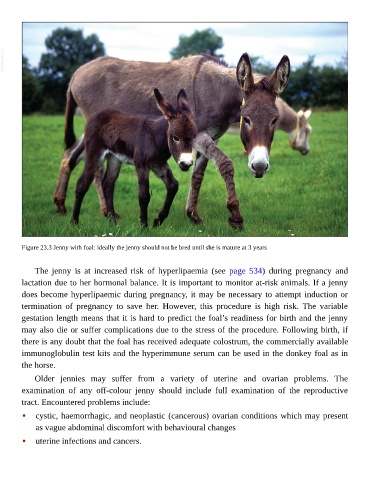Page 1036 - The Veterinary Care of the Horse
P. 1036
VetBooks.ir
Figure 23.3 Jenny with foal: ideally the jenny should not be bred until she is mature at 3 years
The jenny is at increased risk of hyperlipaemia (see page 534) during pregnancy and
lactation due to her hormonal balance. It is important to monitor at-risk animals. If a jenny
does become hyperlipaemic during pregnancy, it may be necessary to attempt induction or
termination of pregnancy to save her. However, this procedure is high risk. The variable
gestation length means that it is hard to predict the foal’s readiness for birth and the jenny
may also die or suffer complications due to the stress of the procedure. Following birth, if
there is any doubt that the foal has received adequate colostrum, the commercially available
immunoglobulin test kits and the hyperimmune serum can be used in the donkey foal as in
the horse.
Older jennies may suffer from a variety of uterine and ovarian problems. The
examination of any off-colour jenny should include full examination of the reproductive
tract. Encountered problems include:
• cystic, haemorrhagic, and neoplastic (cancerous) ovarian conditions which may present
as vague abdominal discomfort with behavioural changes
• uterine infections and cancers.

